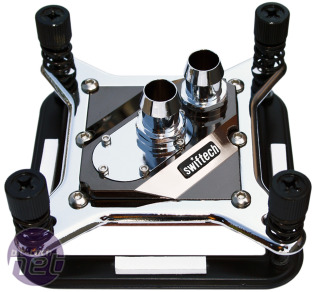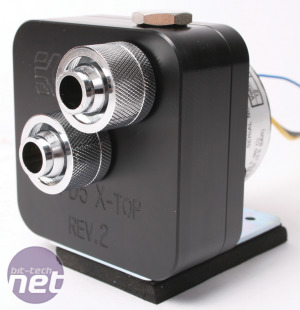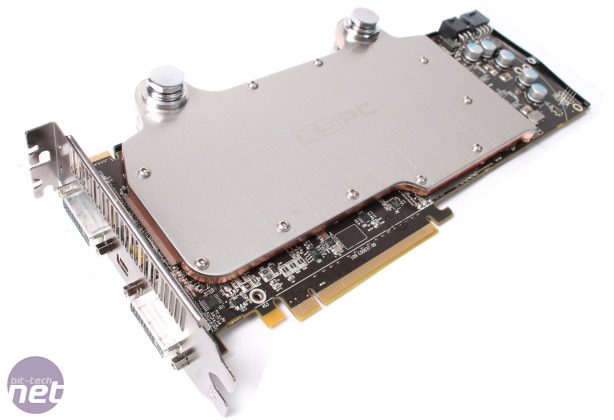Test Setup
To give the HC-500A a thorough workout we needed a selection of the fastest and hottest components we lay our hands on. We could then see how much further the HC-500A would allow us to overclock and overvolt these components compared to the best air cooler (at time of testing), the Titan Fenrir, and a standard water-cooling loop. The latter comprised a Blastflow quad 120mm-fan radiator fitted with eight Scythe Gentle Typhoon fans - this is about as good as water cooling gets.Intel's
 the Core i7-980X Extreme Edition is the CPU that everyone wants, as its six cores and high stock frequency (3.33GHz) ensure it pole position in every benchmark. What's more, thanks to its 32nm transistors and unlocked CPU multiplier, it's also incredibly overclockable.
the Core i7-980X Extreme Edition is the CPU that everyone wants, as its six cores and high stock frequency (3.33GHz) ensure it pole position in every benchmark. What's more, thanks to its 32nm transistors and unlocked CPU multiplier, it's also incredibly overclockable.To ensure that this monster CPU received the most benefit from the HC-500A, we mounted a high-performance Swiftech Apogee XT waterblock on top. This huge waterblock is incredibly easy to mount on LGA1366 motherboards, using a backplate and four spring-loaded thumbscrews. However, you should be careful not to over-tighten the thumbscrews with a screwdriver, as you could snap the standoffs from the backplate under the motherboard.
Despite the huge price drop of the GeForce GTX 480, the Radeon HD 5970 remains the fastest graphics card, and therefore the most drool-worthy. Rather than using one of the recently launched, massively pre-overclocked HD 5970s, we opted for a vanilla card, the Asus EAH5970/G/2DIS/2GD5/A. This uses the reference PCB, so we could easily find a waterblock that would fit it.
The graphics card waterblock in question is the XSPC Razor 5970. As it's made from stainless steel, with a copper interior, the Razor 5970 is a good £30 cheaper than most HD 5970 waterblocks, yet it still provides excellent cooling.
For the motherboard we opted for the Asus Rampage II Gene. Traditionally, micro-ATX motherboards, such as the R2G, were designed to be low-cost alternatives to full-ATX motherboards, and were intended for cheap PCs used in schools, offices and secondary markets such as the the Middle East and Africa. For this reason, micro-ATX motherboards tended to be very poor overclockers, thanks to the basic BIOSes and use of low-quality VRMs.
 However, the R2G was designed with overclocking in mind, and performs as well as the best full-size ATX motherboards.
However, the R2G was designed with overclocking in mind, and performs as well as the best full-size ATX motherboards.As the HC-500A has such a large internal tank, Hailea recommends that you use a pump that has a minimum flow rate of 1,200 litres per hour. This is a big challenge for most PC water-cooling pumps, but the Swiftech MCP655 is powerful enough. When we built Project Beast we modded the pump with an EK D5 X-TOP, which not only makes the MPC655 look brilliant, but also replaces the top-mounted outlet with a side-mounted outlet, making it far easier to install inside smaller cases.
Although the HC-500A is very powerful, it can't cool below 0°C, so we were able to use standard, off-the-shelf 1/2in ID Primochill tubing. As the HC-500A takes the place of the radiator in the loop we built our loop so that the components were connected in the following order:
Pump > water chiller > CPU waterblock > GPU waterblock > reservoir
A word of warning though: adding a radiator to a loop with a water chiller is counterproductive, as the radiator will actually transfer heat from the air into the loop, raising the temperature of the coolant. Do not use a radiator with a water chiller!
Although the HC-500A can cool your PC's components well below sub-ambient temperatures, if you set the coolant temperature significantly below room temperature, then condensation will form on the outside of the tubing and on the waterblocks. If this condensation starts to bead and drop off the tubing and waterblocks it could cause a short circuit, killing your PC.
You can avoid beading one of two ways: either protect your components with a moisture absorbing material such as neoprene pads, or set the coolant temperature to be above the dew point (the temperature at which condensation starts to form) of the room. You can calculate the dew point in your room using this calculator. Fortunately, the HC-500A allows you to control the coolant temperature in 1°C steps, via the small screen and the three buttons on the front panel.

MSI MPG Velox 100R Chassis Review
October 14 2021 | 15:04










Want to comment? Please log in.